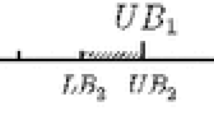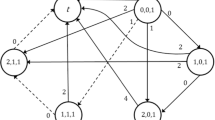Abstract
This paper shows that the single machine scheduling problem with multiple operations per job separated by minimum specified time-lags is NP-hard in the strong sense. Seven simple and polynomially bounded heuristic algorithms are developed for its solution when each job requires only two operations. Empirical evaluation shows that the percentage deviation of the heuristic solutions from their lower bounds is quite low and the effectiveness of these heuristic algorithms in finding optimal schedules increases with an increase in the number of jobs.
Similar content being viewed by others
References
Aanen, E., Planning and scheduling in a flexible manufacturing system, PhD thesis, Faculty of Mechanical Engineering, University of Twente, Enschede, the Netherlands, 1988.
Balas, E., Lenstra, J. K., and Vazacopoulos, A., “The One Machine Problem with Delayed Precedence Constraints and its use in Job Shop Scheduling”, Management Science, Vol. 41, No. 1, 1995, pp. 94–109.
Dell'Amico, M., “Shop Problems with Two Machines and Time Lags”, Internal Report No.93/20, Department of Electronics and Information, Milan Polytechnic, Milan, Italy, 1993.
Graham, R. L., Lawler, E. L., Lenstra, J. K., and Rinnooy Kan, A. H. G., “Optimization and approximation in deterministic sequencing and scheduling: A survey,” Annals of Discrete Mathematics, Vol. 5, 1979, pp. 287–326.
Johnson, S. M., “Optimal two and three stage production schedules with setup times included,” Naval Research Logistics Quarterly, Vol. 1, No. 1, 1954, pp. 61–68.
Kern, W., and Nawijn, W.M., “Scheduling Multi-operation Jobs with Time-lags on a Single Machine”, Working paper University of Twente, Enschede, the Netherlands, 1991.
Lawler, E. L., Lenstra, J. K., Rinnooy Kan, A. H. G., and Shmoys, D. B., “Sequencing and scheduling: algorithms and complexity,” in Graves S. C., et al., Handbook of Operations Research, Vol. 4, Elsevier, Amsterdam, 1993, pp. 445–552.
Riezebos, J., Gaalman, G., and Gupta, J. N. D., “Flowshop scheduling with multiple operations and time-lags,” Journal of Intelligent Manufacturing, Vol. 6, 1995, pp. 105–115.
Author information
Authors and Affiliations
Rights and permissions
About this article
Cite this article
Gupta, J.N.D. Comparative evaluation of heuristic algorithms for the single machine scheduling problem with two operations per job and time-lags. J Glob Optim 9, 239–253 (1996). https://doi.org/10.1007/BF00121674
Revised:
Issue Date:
DOI: https://doi.org/10.1007/BF00121674




